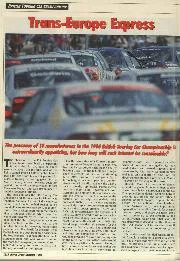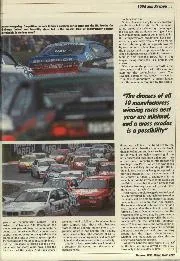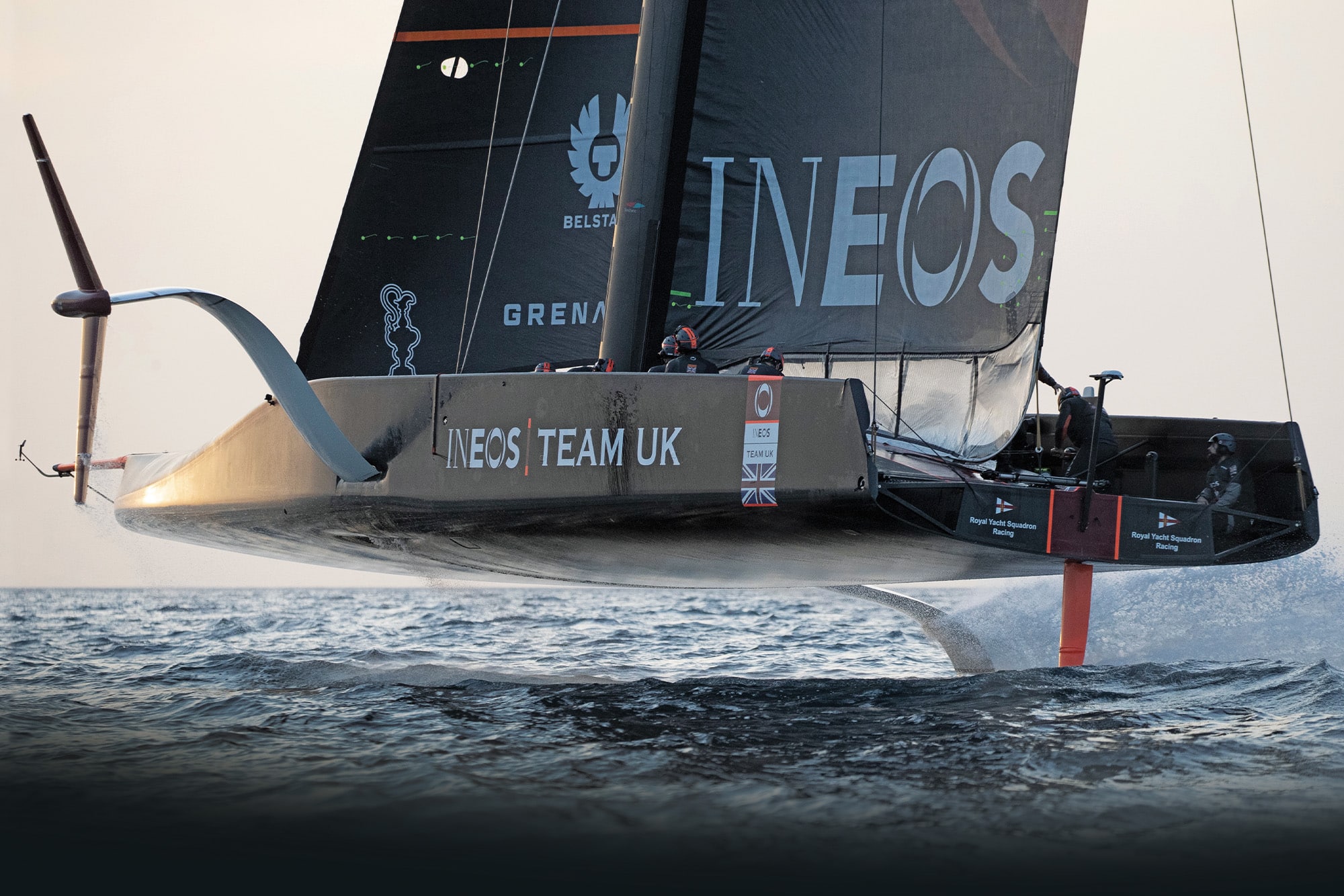

Trans-Europe Express
The presence of 10 manufacturers in the 1994 British Touring Car Championship is extraordinarily appetising, but how long will such interest be sustainable? The chairman of the FIA Touring Car…

With the next America’s Cup just around the corner in 2021, British challenger INEOS Team UK, led by the world’s most successful Olympic sailor, Sir Ben Ainslie, is working with the Mercedes Formula 1 team to help develop the advanced technology required to win.
Historically, motor sport and aerospace have played key parts in the America’s Cup, with names like BMW, McLaren, Prodrive and Airbus among those that have contributed to the development of recent Cup campaigns.
Now, Mercedes has joined that list following the recent announcement of the F1 team’s new sponsorship deal with petrochemical giant INEOS, the same company that backs the British America’s Cup challenge. The joint sponsorship arrangements have allowed Mercedes’ Applied Science arm to bring 18 engineers to work with the British America’s Cup team.
“There’s an incredible amount of synergy across both sports,” says Ainslie. “Mercedes have been phenomenally successful in Formula 1, and there is undoubtedly much we can learn from their organisation.”
With campaign budgets above £120m, the America’s Cup continues to be the most expensive and the most prestigious corner of the sport, but money alone doesn’t always buy an advantage. Time is always in short supply, and it is here that the Mercedes/INEOS Team UK partnership hopes to deliver a benefit.
“For us, the America’s Cup would be like us going from a motorbike to a car and then to a truck,” says Mercedes-Benz Grand Prix project leader Graham Miller, who is one of those who has moved down from Brackley to the sailing base in Portsmouth. “One of the things we bring to the table is extra bandwidth with people who are working on areas that will give reliability as well as efficiency, while also saving time for the team.
“My role is to look after Mercedes-Benz Applied Science, a group that takes the best parts of our operation and applies them to the commercial world. Here we are augmenting INEOS’ capability, with aerodynamicists, stress engineers, control engineers, mechanical designers, simulation engineers, as well as procurement specialists and planners and others. It’s a whole spectrum of support.
“The first thing I noticed when I came to Portsmouth was that there isn’t much in-house manufacturing capability when compared to an F1 team, where we know that to achieve reliability, you need to be able to control the manufacturing, build and assembly processes. So as an example, one of the things that we are doing is building the foils up at Brackley, where we have some of the world’s best manufacturing machine tools. This also helps the rate of performance development as we can simulate specific assemblies and put them through their load cases which also allows us to deliver a plug and play assembly to the sailing team.”
Saving precious time has proved valuable and is readily acknowledged by INEOS Team UK’s chief designer Nick Holroyd. “That rate of performance development is something we hear a lot about from the Mercedes guys,” he says. “In the F1 world, they may plan for a two-second improvement in the car during the course of the season. To help achieve this, they constantly funnel ideas into their design process to find ways of achieving the gains, but they keep this team slightly separated from the car operations team. What’s happening on the car never impacts the development of ideas.
“It was when I saw this that I understood how you get over 100 aerodynamicists working around a car that’s 4.3m x 1.8m and apply that many minds to the issue in a way that is going to deliver the returns that you’re looking for.
“The level of detail that they are used to looking at also provides a key. If you can find, say, 10 small details that you can execute really well, they will add up to the gains you may have been looking at when you were feeling under pressure to decide between concept A and concept B.
“Normally, because of the limited resource we’ve typically had, we would tend to go to look at the big rocks in the field and consider how to manipulate them, but with this additional resource and the Mercedes mindset, we’ve been able to drill down into the finer detail.”
Miller also points out another significant advantage from the partnership between the two outfits, away from the design process.
“The procurement and planning functions has been another important area that we have helped with,” says Miller. “It comes back to the bandwidth issue. You can have the best design in the world, but if you don’t leave enough time to produce it, it is no good to anyone.”
So, when it comes to the hands-on experience, just how different and challenging are these boats to sail? Ainslie has been involved in many different America’s Cup teams since his first in 2000. He was the second helmsman for Team New Zealand in the ’07 campaign, and then tactician for Oracle Team USA in their spectacular comeback in ’13 aboard the AC72 catamaran.
He knows the America’s Cup well but is quick to acknowledge the helping hand that he received in his Land Rover BAR campaign in 2017 from Prodrive’s founder and current Motorsport UK head David Richards.
“David helped me a huge amount in the early days of BAR,” says Ainslie. “I knew him through the Cornish sailing community [where Ainslie had grown up]. Once we got the team up and running, Prodrive were instrumental in terms of helping us get up to speed with the system design and management and monitoring. We would have struggled massively without their help in the last campaign.”
“The new boats are even more technical this time around,” he continues. “Sailing downwind, we are regularly hitting 45 knots (50mph). The AC75 is very sensitive to heel, so the job is more about being absolutely perfect on balance. If you’re slightly off, the boat gets out of balance, and you can wipe out very easily.”
One way of imagining the balancing act is to consider a conventional four-wheeled car versus a tadpole tricycle configuration, (where the single wheel is at the back), going around a corner at speed. When the conventional car rolls to one side through the turn, say to the right, it will start to roll towards the outside of the corner around the front and back wheels on the left-hand side of the car. In this case, both wheels are parallel with the centreline of the car, and there will be no change in fore and aft trim.
On a tadpole tricycle, as the vehicle turns around the bend it too rolls towards the outside of the corner but the two wheels it is balanced on are not parallel with the centreline of the car, and the nose will tend to pitch up.
The same happens on an AC75, which is balanced on a similar tadpole configuration. But the boat is much more sensitive to roll, as the rules only allowed it to sail on two of the three foils, one main foil out to one side and the T-foil rudder at the back. As a result, the bow pitches up and down depending on the heel.
This in turn causes issues with the amount of vertical lift that the foils are generating as well as affecting the overall stability of the boat. It’s a delicate balancing act, unlike any other boat.
All of which is made harder with the challenges that come with communicating with the 10 other crew who are all wearing helmets, with their backs to the helmsman, travelling at motorway speeds in an already noisy environment, aboard a bucking bronco of a boat.
“It can be quite scary at times,” adds Ainslie. “It is more akin to flying an aeroplane where one of the first things you’re taught is not to keep overreacting the whole time. That’s the same in flying with these boats.” With so many variables, it is easy to get out of shape quickly both on and off the water. It is here that Ainslie is clear on the importance of the Mercedes support behind the scenes.
“It’s impossible to overstate how positive the relationship has been for us with Mercedes. In the last cycle, we had some people from McLaren and Red Bull, who were fantastic and helped us in some key areas. But this new relationship with Mercedes has really been a step up from that in terms of their commitment, in the way they have wanted to make it work for us, and the amount of resources that they have brought.”
But as Ainslie and his team know, until the boats line up on the start line for the first time, no one knows anything for sure. “What we do know, though, is that there will be a lot of nervous designers and sailors standing on the dock on the eve of the first event.”
There’s also the certainty that whatever the pundits see on the water, it won’t be a hoax, but the fruits of a collaboration with F1’s dominant team.
Matthew Sheahan is one of sailing’s leading journalists and has covered every America’s Cup since 2002

The first race in 1851 showcased the technical advances in sailing. That trend hasn’t changed in 169 years of racing
The America’s Cup is the world’s oldest international sporting trophy. Originally named the £100 Cup and awarded to the winner of a race around the Isle of Wight, it was set up to celebrate the Great Exhibition in 1851. In a fleet of 15 competitors, it was the yacht America that won and took the trophy back to the USA, where it was renamed the America’s Cup and handed to the New York Yacht Club. Despite many challenges from other national yacht clubs, it remained there for 132 years to mark the longest winning streak in sporting history until the Australians lifted the trophy in 1983. Great Britain has mounted more challenges than any other country during the 169 years, yet it has never won the America’s Cup. The next America’s Cup will be the 36th edition of the “Auld Mug” and is due to take place in New Zealand in March 2021.

The carbon-fibre mast is an aerofoil shaped section and rotates to provide a more efficient shape on the low-pressure side of the mainsail. The 145m2 sail is double skinned to create more of a wing section shape.
The lower section of the mainsail is sealed against the deck for greater aerodynamic efficiency, it’s clear to allow the crew to see through to the leeward side of the boat to see potential conflicts with their competitor(s).
Like an aircraft’s wing and aileron, the AC75 hydrofoils have articulating trailing edges which control the amount of vertical lift that is produced when the foil is in the water to lift the 6.5-tonne boat above the water’s surface.
The canting arms raise and lower the hydrofoils into the water using hydraulic rams inside the boat. Built from carbon fibre, the arms need to support the weight of the AC75 but also oppose the huge loads that are trying to capsize the boat. These items are one of the few components that are common to all the boats.
With speeds around 45 knots (50mph), the wind speed over the deck can easily exceed 60 knots (70mph). Aerodynamic drag is a big factor, hence crew are kept low, and the hull and deck are streamlined.
The single rudder has a T-foil on the bottom and acts like an aircraft’s tailplane and keeps the boat trimmed correctly fore and aft.
The pioneering technology behind the world’s fastest racing boats can be traced back to 2012. Back then, experts dismissed the idea of using hydrofoils on the basis that the 72ft wing masted catamarans for the 2013 America’s Cup in San Francisco were already overpowered, twitchy machines at the leading edge of the sport. Flying them would surely be a step too far, and hydrofoils had been outlawed by the rule makers anyway.
But the Kiwi hydrofoils were both real and legal. Like the best F1 engineers, the New Zealand challengers had identified and exploited a loophole in the rule and caught its competitors off guard. Yet the Kiwis weren’t to know the effect their flying machine would have on the rest of the sport.
Eight years later and a new generation of foiling designs stretching from grand prix to grass roots boats has evolved and led to the biggest increase in performance the sport has ever known. The change is underway and driven largely by the latest developments in the Cup world.
Today, the 72ft cats of 2012 look crude when compared to the current generation of extraordinary 75ft flying monohulls (the AC75 class) that will be used in the 2021 America’s Cup. Scorching around at speeds approaching 60mph, flying on hydrofoils that lift the entire hull and 11-man crew clear of the water, the keelless, six-tonne monohulls are taking the race into completely new territory. When the AC75 class was announced in 2017 after New Zealand’s victory, many questioned whether it was technically possible to balance a single-hulled boat of this size with no keel on just the two hydrofoils.
But now all four teams – Cup defenders Emirates Team New Zealand and the three challengers; INEOS Team UK, American Magic and Luna Rossa Prada Pirelli – have launched their first boats and we have seen that the AC75s do indeed fly.
Length: 22.86m (75ft)
Beam: 5m (16ft)
Draft: 5m (16ft)
Weight: 6450kg (14,220lb)
Mast height: 26.50m (87ft)
Mainsail area: 145m2 (1560ft2)
Jib/genoa area: 90m2 (970ft2)
Spinnaker area: 200m2 (2200ft2)
Construction: Carbon fibre
Crew: 11 + 1 optional guest
https://youtu.be/Uw50DYWrs2E